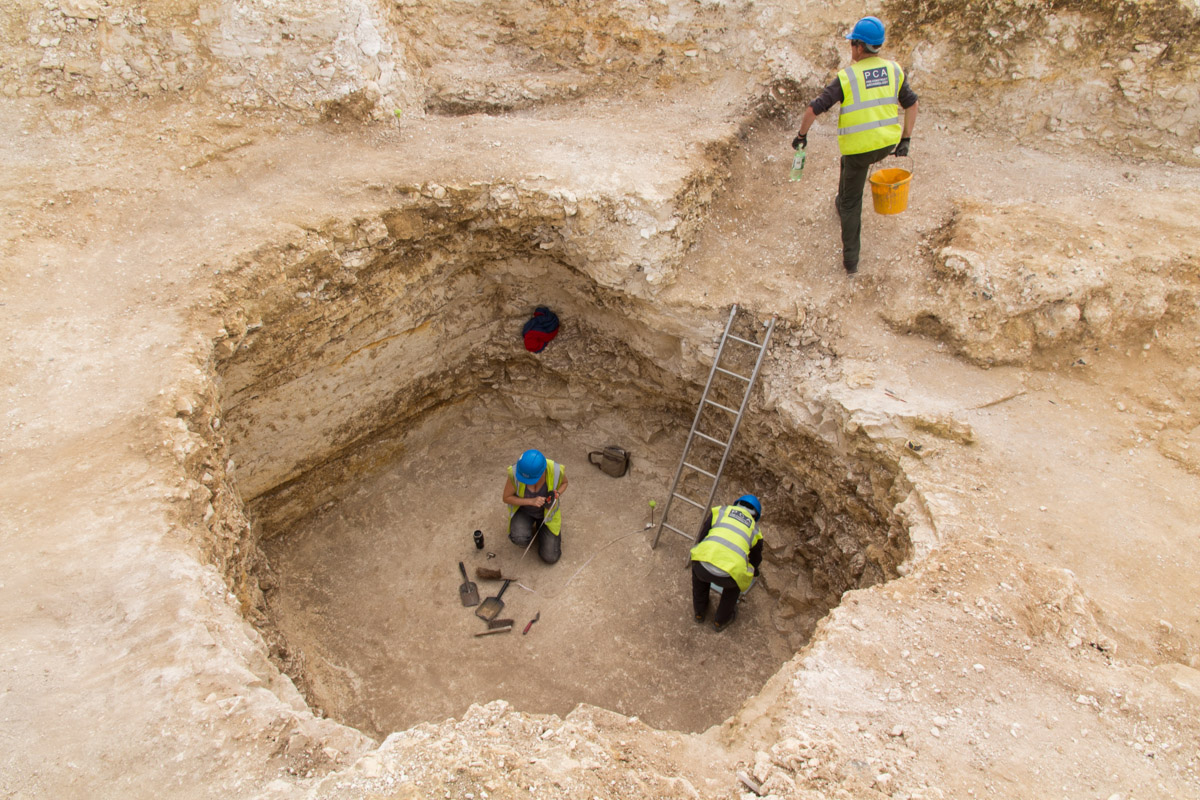One of the largest collections of human and animal bones ever seen in a Roman feature in Britain has been discovered inside a ritual shaft at an ancient chalk quarry. Located in Surrey, southeast England, the 2,000-year-old pit contains the remains of 21 people as well as a dog penis bone that appears to have been decorated with red ochre.
“There are no other published examples of ochre-stained bones from Roman or Iron Age Britain, and given the context from which it was recovered, it seems probable that this bone represents some sort of ritual item,” writes Ellen Green, the author of a new study about the remarkable assemblage.
Ritual shafts were dug throughout Roman Britain, with a particularly large number found in Surrey and Kent. Typically filled with offerings, these pits are thought to be associated in some way with the underworld, although their exact purpose remains something of a mystery.
According to Green, many of these shafts have been found to contain the remains of dogs, giving rise to the idea that they may be linked to fertility, since canines were associated with the Roman gods of abundance and reproduction. Seeking to learn more about these mysterious chasms, she turned her attention to a quarry shaft at The Nescot College Former Animal Husbandry Centre in Ewell, Surrey, which was originally excavated in 2015.
“The Nescot shaft is unusual in the scale of deposition, with a bone assemblage of around 11,400 identifiable fragments representing a minimum (MNI) of 282 animals and 21 humans,” she writes. Based on the presence of a coin from 77 CE, the author determines that the ritual offerings were placed in the tunnel during the first and second centuries.
Strangely, only one of the human skeletons remained in an articulated state, with the other 20 having been intentionally manipulated and rearranged, with certain bones removed. The single intact body belonged to a woman who was over the age of 45 at the time of death, while the remaining fragments were linked to individuals of various ages, ranging from children to adults.
Notably, 70 percent of the animal remains were canine, predominantly small terriers and lapdogs. Large numbers of young animals – including puppies, piglets, and foals – were also present, supporting the idea that the ritual shaft may have been somehow connected to birth, reproduction, and fertility.

Researchers found thousands of bones in the large shaft.
Image credit: Pre-Construct Archaeology
However, the most intriguing item found at the site was a dog baculum – or penis bone – that had been stained with an iron oxide pigment, most likely red ochre. “While the presence of bacula is not in and of itself unusual, the staining on this specimen is indicative of human manipulation,” writes Green, indicating that the item likely held special significance.
“A penis bone has obvious connotations, particularly given the already strong association between dogs and fertility within Roman Britain,” she continues.
Considering the entire assemblage of human and animal bones found within the shaft, the author concludes that “the evidence does support a link to ideas of abundance, new life and the agricultural cycle.”
“In this case a feature full of the dead becomes a potential symbol of new life and regeneration, adding to the ever growing tapestry of Romano-British belief,” she writes.
The study is published in the Oxford Journal of Archaeology.
Source Link: First-Ever Painted Penis Bone Found In 2,000-Year-Old Roman Ritual Shaft